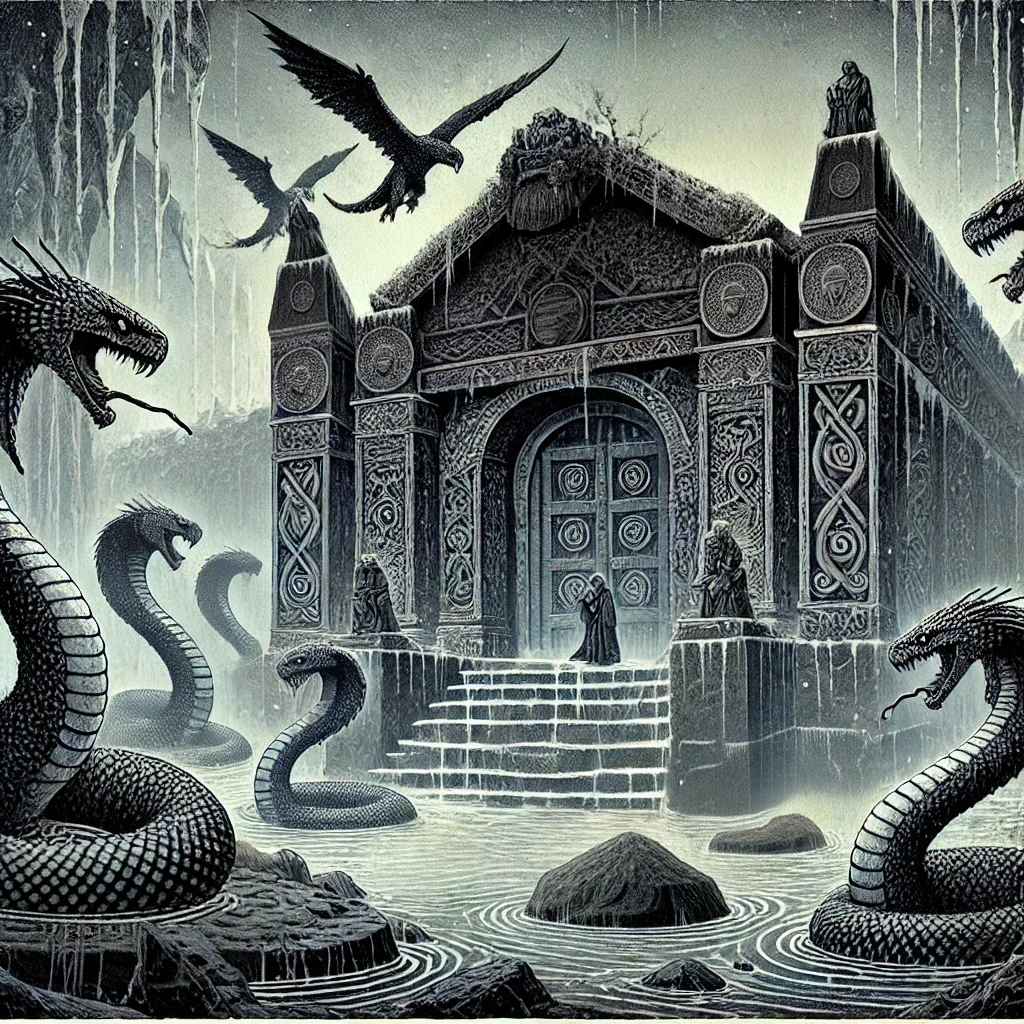
Table of Contents
- Overview
- Characteristics
- Correspondence with Norse Mythology
- Nicors and Neowlan Grund
- Haddingus’s Journey to the Underworld
- References
Overview
Wyrmsele is a concept from Heathen Anglo-Saxon cosmology, representing a grim and eerie place deep within the underworld. The name translates to “Hall of the Serpent,” and it is depicted as a cold and watery realm inhabited by monstrous serpents and other horrors. This domain is a place of great suffering and torment for the wicked.
Characteristics
Unlike the fiery depictions of Christian Hell, Wyrmsele is characterized by its chilling, damp environment. It is filled with serpents and other dreadful creatures, emphasizing its cold and harsh nature. This depiction aligns with various Old English literary sources, such as Christ and Satan and Solomon and Saturn, where it is described as a place where serpents entwine around the damned and the landscape is bleak and unforgiving. In Christ and Satan, the hall is described as filled with terrible things, including naked humans struggling with serpents, highlighting the cold and harsh nature of the underworld (Old English Poetry) (Wikipedia).
Correspondence with Norse Mythology
Wyrmsele shares notable similarities with the Norse concept of Náströnd, a shore in the realm of Hel where the dead suffer torment. Náströnd, meaning “Corpse Shore,” is depicted as a cold and dismal place, inhabited by venomous serpents that spew poison onto the damned. However, in Old Norse mythology, Náströnd and the hall of serpents are two related but distinct locales. The hall stands near Náströnd and is described as having walls made of serpents’ bodies that drip venom, creating a torturous environment for the inhabitants.
Similarly, Wyrmsele is located near Neowlan Grund, which translates to “Abyssal Bottom” or “Corpse Ground.” Neowlan Grund is described as lying down the river of swords, in the nethermost regions of the Neowolness. Neowlan Grund is the Old English equivalent of Náströnd, making them near cognates in their respective mythologies. Both locales are associated with cold, watery environments filled with serpents and other horrors, serving as punitive realms for the wicked.
Within Neowlan Grund stands Wyrmsele, the Hall of Wyrms. Dragons guard its doors, and within, no joy is found. This place is a grim abode for murderers, villains, and those who bear false witness, who reside here in perpetual misery.
Nicors and Neowlan Grund
Nicors are water-dwelling monsters mentioned in Old English literature, including Beowulf, where they are described as dangerous creatures inhabiting cold, watery environments. Old English poetry suggests that these creatures swim in those abyssal waters, around Wyrmsele, further reinforcing the imagery of Wyrmsele as a cold, watery place of terror, populated by monstrous beings (Old English Poetry).
Haddingus’s Journey to the Underworld
In Saxo Grammaticus’s Gesta Danorum, the legendary Danish hero Haddingus embarks on a journey to the underworld that shares similarities with the description of Wyrmsele. Guided by a mysterious woman, Haddingus traverses through a smoky veil of darkness, crosses a river filled with weapons, and encounters souls suffering in a cold and bleak landscape. This journey emphasizes the themes of punishment and the harsh, unforgiving nature of the underworld (Medievalists.net) (Cambridge).
References
- Christ and Satan and Solomon and Saturn for descriptions of Wyrmsele.
- Saxo Grammaticus’s Gesta Danorum for the journey of Haddingus.
- Comparative mythology studies, such as those by John Lindow and Hilda Ellis Davidson, for analysis of Wyrmsele and Náströnd.
For further reading, consult the Prose Edda and Poetic Edda, as well as secondary sources on Norse and Anglo-Saxon mythology.
